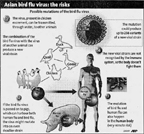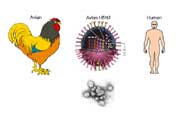|
|
 |
||||
|
Volume 13, Issue 34 ~ August 25 -31, 2005
|
|||||
 Are You Ready? Are You Ready?A Deadly Strain of Avian Flu May Be Winging Our Way by Sandra Olivetti Martin Rising in China is an influenza so deadly that it could sicken 80 million people and kill 16 million around the world, according to the Centers for Disease Control and Prevention. Like all influenza A viruses, this deadly flu — called type H5N1 — begins in birds. Migratory aquatic and shore birds such as ducks, geese and herons are its hosts, with whom it lives peaceably. Where the loss of these birds’ migratory routes has brought them into direct contact with humans in farms and parks, avian flus turn deadly. The problem starts, according to University of Maryland virologist Daniel Perez, “when the virus jumps to other species.” Domestic birds begin the deadly transmission. Pigs may be the next step, and finally humans. Lots of flu strains make those jumps. But when a particularly virulent one goes hop-scotching, it can spread disease and death so efficiently that even war can’t compare in deadliness. As World War I was ending, a flu that came to be called Spanish influenza proved that point. It probably didn’t start in Spain — indeed, Kansas is a likely candidate — but it soon arrived there, piggybacking on troop ships. In five years, the war killed at least 17 million people. In two years, Spanish influenza killed at least 21 million people; estimates rise as high as 100 million. It struck in such distant locales as Alaska, Sierra Leone, Russia and New Zealand. The nasty H5N1 virus, experts warn, could be even worse.  Maryland Mounts Front-Line Defenses Maryland Mounts Front-Line DefensesHere at home, Maryland is Avian Flu Central. In part, we earn that designation because we’re vulnerable, and we’re experienced. Chickens are Maryland’s biggest crop. They’re concentrated on the Eastern Shore, where Maryland combines with Delaware and Virginia to raise $1.7 billion worth of chickens each year. There, some 14,000 poultry company employees and 2,100 farm families raise chickens for four major poultry companies. We’re experienced because a lesser avian virus, the H7N2 strain, struck Delmarva last year. In its wake, 350,000 chickens were slaughtered. But it’s more than experience or vulnerability that earns us the title of Avian Flu Central. We’re also leaders in the campaign to keep avian flus from hopping species from their waterfowl hosts. Headquarters on that front is the University of Maryland, with its Avian Influenza Virus Program at the Virginia-Maryland Regional College of Veterinary Medicine. Directing the Prevention and Control of Avian Influenza program is University of Maryland virologist Daniel Perez. Perez coordinates the work of researchers in 17 states in a $5 million campaign, funded by the largest grant ever made by the U.S. Department of Agriculture to study a single animal disease or health threat. The goals of the avian influenza project “include epidemiology, surveillance, diagnostics, vaccines and education,” Perez explains. Perez’s specialty is epidemiology, deciphering at the molecular level how avian influenza jumps between species. For surveillance, front line teams are mounted to detect infected birds at each of the nation’s four major flyways. Along the Atlantic Coast, we’re one of those flyways, bringing more than good birding. The project also seeks “fast and easy” diagnostic tests for birds and is developing a vaccine for poultry. Another big part of the project — Perez calls it “huge” — is education. Students won’t be you and me, or even commercial poultry producers. Instead, the students Perez is seeking are game-bird producers and live-bird markets, potential links in the chain of infection mos
Guarding the chicken house, of which the Eastern Shore has so many, is outside the territory of the Prevention and Control of Avian Influenza program. On that vital front, Maryland’s own homeland security is at work. Chicken houses are vulnerable, Perez says, because “once introduced, avian influenza is very easy to spread from flock to flock. Movement of infected birds, excretions from infected birds, if carried in contaminated equipment, clothing, hands, shoes, egg flats, feed trucks, water and food are all major contributors in the spread of the virus.” On this front, the Delmarva poultry industry, animal and human health professionals and state and local governments have mounted an early defense. The Delmarva Protocol, completed this month, unifies the Eastern Shore against avian influenza. For the region, the Protocol standardizes the recommendations of the federal Centers for Disease Control and Prevention and Occupational Safety and Health Administration. “Between our avian influenza last year and what we’ve been reading about in Asia, we realized we needed proactive measures and took the bull by horns,” says Maryland Department of Agriculture spokeswoman Sue duPont. Most of the security measures aren’t new; now, however, they’re standard and universal. “Procedures, reporting forms and measures … have been developed and accepted by each party, making the activities of each state and company consistent with one another,” duPont explains. Maryland Agriculture Secretary Lewis R. Riley calls the Protocol “the first of its kind in the nation and … a model for other states.” Think of all that scrubbing, disinfecting and paperwork over on the Eastern Shore as the front line of defense against one of the most powerful armies of infection ever evolved. As you think, remember the caution of veterinary virologist Daniel Perez. “Humans have altered the ecosystem of many animal species … creat[ing] optimal conditions for the emergence of novel influenza virus strains,” Perez says. “It has been good for us that avian influenza viruses have difficulties transmitting from human to human, but in my opinion, it’s just a matter of time.”
She is the author of two major public health books — Betrayal of Trust and The Coming Plague: Newly Emerging Diseases in a World out of Balance — and has been a science correspondent at National Public Radio. Garrett is now Senior Fellow for Global Health at the Council on Foreign Relations. She wrote “The Next Pandemic?” for the July/August issue of the council’s magazine Foreign Affairs. In it, she writes “If the relentlessly evolving virus becomes capable of human-to-human transmission, develops a power of contagion typical of human influenzas, and maintains its extraordinary virulence, humanity could well face a pandemic unlike any ever witnessed. “Or nothing at all could happen.” Q What’s happening on the avian flu front? A It is becoming more of a danger physically, and to add to that there’s been a steady effort by the public health community to get policymakers more aware and more concerned about the situation. That is meeting with some success, finally. Q Where is this avian flu coming from? A Avian influenza viruses seem to originate in southern China, in the Pearl River Delta region. It’s a unique ecology, with a tropical climate, extremely dense human population, a booming economy with rapid Gross Domestic Product growth and giant mega-cities sprouting up overnight. But meanwhile, there is a large peasant population still conducting traditional poultry rearing in the way they have for centuries. The Chinese predilection for purchasing live animals that are slaughtered at home means that possible routes of exposure are infinitely greater than what would be the case in the U.S. The virus is normally carried by aquatic migratory birds, including ducks and geese, that transverse the Asian Flyway, extending from southern Indonesia all the way up into the Arctic Circle of Siberia. The largest landmass on this migratory route is China, which has really devastated its natural ecology. So the birds are unable to find many pristine natural places to land as they make their migration every year. They’re landing on farms and getting into fights with domestic animals over food and water. The ecology of this virus is very much about what’s going on right now in China. And then it’s compounded by rising GDP growth, which means that more Chinese people can now afford to eat protein on a regular basis. So a family that just as recently as 10 years ago would slaughter a chicken only on a special occasion can now afford to have a chicken every week. Soon, most Chinese may be able to afford to have chicken or pork every day, just as we can. That is going to dramatically increase the number of livestock being reared in China, with very dire potential outcomes. So all of this means we’re hastening the probability of the emergence of a truly lethal flu strain. Q How does avian influenza spread? A I wish we knew the answer to that question. There’s evidence of transmission via dining on the meat of animals. There’s evidence [of transmission through] some very, very close contact with chickens, such as professional cock-fighting roosters. But it’s all rather mysterious: Lots and lots of chicken handlers, chicken farmers and poultry workers are infected. And then we find infections in people who seemed to be several steps away from any chickens. So it’s all quite baffling. Q Are vaccines effective for threats like avian flu? A The only diseases we have any hope of eradicating — and I’m not really sure that we’re ever going to eradicate any more diseases besides smallpox — are ones that are present only in humans and are not found in animals. So smallpox was unique in that the vaccine was 100 percent effective. It was easy to spot people who were infected because they had very gross and obvious physical symptoms, and there were no animals that harbored that virus. Avian flu is not like that; we are the final end point on a long food chain of animals that this virus goes chopping its way through, and as it does so it constantly mutates. A vaccine that is effective against the flu strain one year may have very little, if any, effect against the flu strain circulating the next year. So influenza is just orders of magnitude more difficult to deal with. Editor’s note: In August, a vaccine against H5N1 was successfully tested in Baltimore, Los Angeles and Rochester, N.Y. But production isn’t far enough along to deliver the vaccine to the nation. Antiviral drugs are also being prepared in other parts of the world. Q Modern transportation systems also help spread disease. I understand, for instance, that it would be very easy for a single mosquito infected with West Nile to travel to Hawaii on board one of the frequent flights. A Right after the World Trade Center attack, Hawaii was contending with the fact that the country was in a panic about anthrax. Hawaii was being deluged with claimed anthrax samples, and at the very same time dengue hemorrhagic fever had arrived in the form of mosquitoes that had hitchhiked their way from Asia. And, of course, the latter was a much more serious problem for the state of Hawaii, but its resources were sorely taxed at that time. And so several people did end up getting dengue fever on the island of Maui. Q What is the likelihood of mass human-to-human transmission of avian flu? A If we could say what the odds were, we could immediately advise policy makers on what they ought to do. But we don’t really know what genetic change the virus has to undergo to become a rapid human transmitter, and therefore we can’t really tell how close it is.  It may have at least three different ways of doing it. One involves recombining in a host that’s dually infected with a normal human flu virus and then the H5N1. Or it may be that the H5N1 is constantly undergoing mutation, and we certainly see that — it’s known as antigen drift — in flu viruses all the time. There may be a third process that involves a more active genetic mechanism inside mammalian cells, particularly in pig. It may have at least three different ways of doing it. One involves recombining in a host that’s dually infected with a normal human flu virus and then the H5N1. Or it may be that the H5N1 is constantly undergoing mutation, and we certainly see that — it’s known as antigen drift — in flu viruses all the time. There may be a third process that involves a more active genetic mechanism inside mammalian cells, particularly in pig.The actual biology is not well enough understood to be able to make a prediction. One aspect we don’t really understand is this: If the virus makes the genetic change to become human transmissible, does it give up its virulence in the process? We hope so, but we don’t know, actually. So, there are many factors that play into trying to map it out. Imagine if you had a supercomputer and you were trying to do a future forecast about what might happen with this epidemic. The number of input factors is just enormous and several of them are unknown. Q Do you think the CDC is doing what it should be doing in terms of preventative action? A I think the CDC is doing a lot. But what I keep trying to get across to people is that flu starts in Asia. We’re a lot better off if we can stop it in Asia than if we wait until it is here and try to figure out some means to minimize the damage. In a recent study published in Nature, a team at Oxford University did a computer model simply asking if it is possible to stop pandemic flu. The good news is their answer is yes, it is possible. But the bad news is it can be stopped only if you identify it when there are just 30 human cases. We’re not going to spot those first 30 human cases before it spreads to hundreds or thousands of people unless we have a much better infrastructure of public health, vigilance and surveillance in poor countries like Vietnam, Cambodia and Laos, and in countries with more money but completely lacking in sophisticated public health infrastructure, like China. Those countries are not going to be able to make the necessary changes overnight. They are going to require a lot of assistance, a lot of expertise, a lot of money, a lot of support. The CDC is doing some of that, but we’re not ramped up on an urgent basis. We’re still operating as if we have a lot of time, but we don’t know how much time we have. Q So fighting avian flu is going to take multinational political cooperation? A It’s China with whom we need to be collaborating on this. Vietnam is another crucial partner. But it’s hard when some members of Congress still think of them as the enemy. The problem is that at a higher political level it has to do with how our government perceives its role in the world and how it deploys resources. We tend to prefer as Americans — and particularly with this administration — to operate on a bilateral or unilateral basis. We like to go it alone or we like to forge very intimate alliances with particular countries we tend to get along with. We’re less happy working with big multinational mechanisms, with the United Nations system, with other big umbrella organizations. It’s hard to work with partners that come from different political systems and cultures. It takes a lot of patience and it doesn’t always work out the way you want it to. But I don’t think we have much choice in the context of pandemic flu. Q What’s happening on the U.S. front? A Woefully lacking is really detail-level strategic planning by communities and states: thinking about what we will do. What if pandemic flu is in Oregon and I’m the governor of California? Do I threaten to cut the border between Oregon and California? We really haven’t planned sufficiently, and some parts of the country haven’t done it at all for pandemic flu. Most political leaders will do things that are ultimately destructive, but will in the short term appear to be responsive. They have to do something, so they will try quarantines and closed borders, they’ll try slaughtering millions of chickens or shutting down the whole poultry industry. In contrast, many of the hardball things that might make a difference won’t be thought of or addressed. You have to prepare in advance and go through this thought process, so that a governor, a state legislator, a state or city health commissioner, has some kind of guide to work from. Fortunately, the CDC just released in the last 30 days a detailed flu response cookbook, if you will, for the federal level. But I still think we have a long way to go. |
|||||
|
|
|||||
|
© COPYRIGHT 2004 by New Bay Enterprises, Inc. All rights reserved.
|


